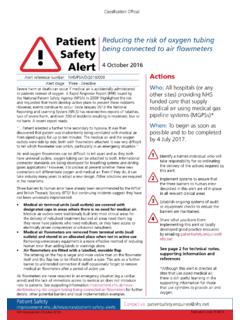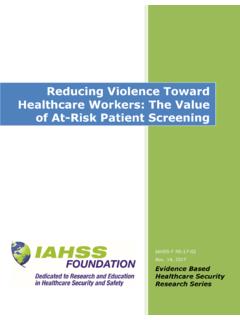Transcription of Reducing the risk - Barnardo’s
1 Reducing the risk: Barnardo's support for sexually exploited young people A two-year evaluation Sara Scott and Paula Skidmore Reducing the risk: Barnardo's support for sexually exploited young people A two-year evaluation Sara Scott and Paula Skidmore Reducing the risk Published by Barnardo's Tanners Lane Barkingside Ilford Essex IG6 1QG. Charity registration number 216250. Barnardo's 2006. All rights reserved. No part of this publication may be reproduced, stored on an unauthorised retrieval system, or transmitted in any form or by any means without prior permission of the publisher.
2 A catalogue record for this book is available from the British Library. ISBN 1-904659-36-5. Contents Page Figures and tables iv Acknowledgements v Foreword vi Executive summary 1. 1 Introduction 7. 2 Barnardo's service users 13. 3 Outcomes for young people 34. 4 The Barnardo's model of practice 48. 5 The policy context and perspectives of local stakeholders 65. 6 Conclusion:The challenge continues 76. Appendices A Participatory research approach 78. B Interview schedule for service managers 80. C Interview schedule for stakeholders 82.
3 D Interview schedule for practitioners (case histories) 83. E Outcome monitoring form 85. F Measuring outcomes 91. G Barnardo's statement of ethical research practice 99. H SCIP guidance on the role and responsibilities of lead agencies 107. References 109. iii Figures and tables Figures Page 1 Age of young people accessing Barnardo's sexual exploitation services 36. 2 Differences in risk levels between those young people only seen at initial assessment and those reaching final review 38. 3 Mean level of sexual exploitation by age 39.
4 4 Level of sexual exploitation by age at initial assessment 39. 5 Level of exploitation at initial assessment by gender 40. 6 Mean level of exploitation by risk category 41. 7 Young people going missing at initial assessment and final review 43. 8 Mean scores for going missing by level of exploitation at initial assessment 44. 9 Rights and risk awareness at initial assessment and final review 45. 10 Young people's relationships with carer at initial assessment and final review 46. A1 Box plot: distribution of scores for young people assessed only at initial assessment and young people assessed at final review 97.
5 Tables 1 Ethnicity of young people 16. 2 Sources of referral 17. 3 Outcomes for young people not reaching a first review 37. 4 Young people and overall level of risk 40. 5 Level of sexual exploitation by age: initial assessment and final review 42. 6 Level of sexual exploitation by gender: initial assessment and final review 42. A1 National outcomes 92. A2 Time between reviews 93. A3 Number of excluded cases by category 94. A4 Non-recorded data by variable at initial assessment 95. A5 Differences in risks between young people under 18 reaching final review and initial assessment only 96.
6 A6 Repeated measures t-test: sexual exploitation 98. A7 Repeated measures t-test: lifestyle risks , young people under 18 98. A8 Repeated measures t-test: lifestyle risks , young people over 18 98. iv Acknowledgements The national evaluation could not have succeeded without the full co-operation and support of our service managers and practitioners. We would like to thank all the staff teams from Ace, Base, Beyond the Shadows, Face, Glasgow Street Team, Merseyside Scheme, Missing in Yorkshire, Streets and Lanes, SECOS, Space, Southampton Young Women's Service,Young Women's Project and Young Men's Project, who gave us considerable time and consideration during our visits to services.
7 Special thanks to the practitioners for sharing their experiences of their work to support young people in need. We would like particularly to thank the service managers who were in post through part or all of the period of the research; Daljeet Dagon, Di Foley, Libby Fry, Ralph Lillywhite, Ann Manzi, Jaqui Montgomery-Devlin, Jaci Quenell, Wendy Shepherd, Sue Sainsbury, Debbie Southwood, Duncan Stanway, Gloria Stott, Helen West and Ginny Wilkinson. Particular thanks are also due to Tink Palmer and Ginny Wilkinson in their roles as Barnardo's Principal Policy and Practice Officers for sexual exploitation.
8 Throughout the period of the evaluation, Barnardo's research team was grateful to receive grants for sexual exploitation research from a number of external bodies: the Daphne Programme (2002/4) and the Agis Programme (2005/7) from the European Commission; the Kahan Trust; and Bridge House Estates. Although these bodies did not directly fund the research reported here, they made a valuable contribution to our research in this field. Thanks go to those colleagues who facilitated a period of secondment for Paula Skidmore from the Department of Applied Social Sciences and the Centre for Social and Evaluation Research at the London Metropolitan University (2003/5).
9 Special thanks are due to Zoe Harper and Gillian Holden for their work on the outcomes monitoring and statistical analysis; to Pip Tyler; to Sylvia Potter for editorial work; to Cathy McMahon for her huge contribution to the effective management of contracts, budgets and publications; and to all our colleagues in Barnardo's Policy and Research Unit. v Foreword It is now more than 10 years since Barnardo's opened its first service for sexually exploited young women in Bradford. Our Street and Lanes' service was a pioneering project reaching out to some of the most vulnerable young people in our society: those involved in sexual exploitation, whose difficulties and disadvantages had drawn them away from their peers, their parents, and any positive connections with professionals.
10 Working with this group of young people is extremely challenging. Over the past decade Barnardo's has developed its understanding of how young people become vulnerable to exploitation and the multiple risk factors which lead them to fall prey to abusive adults and dangerous lifestyles. Barnardo's now has 14 services for young women and men in towns and cities all over the UK and has developed ways, often in partnership with other agencies, of reaching and working with young people to bring an end to their abuse and help them build new lives.















